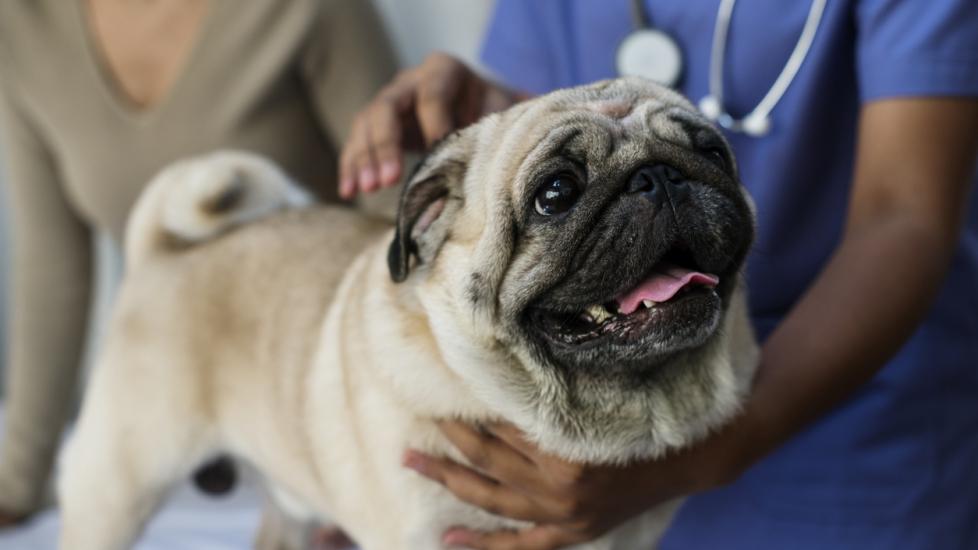Warts in Dogs
What Are Dog Warts?
Canine viral papillomatosis sounds serious, doesn’t it? But the term is just a technical description for warts (papillomas) in dogs. While a diagnosis of dog warts is rarely serious, the condition is worth your attention, primarily so you don’t confuse warts in dogs with other, nastier diseases.
Any dog can get warts, but they are more common in dogs who are immunosuppressed or spend a lot of time around other dogs. Young dogs frequently get warts in their mouths, while the skin of older dogs is more frequently affected. Certain breeds also seem to be at an increased risk of dog warts, including:

Symptoms of Dog Warts
Warts on dogs often look like a small head of cauliflower, but other, rarer types do exist, including an inverted papilloma (usually a firm lump with a dot in the middle) and dark, scaly plaques of skin that have an irregular surface.
Warts can develop in and around a dog’s mouth, around the eyes, between the toes, and almost anywhere on the skin.
Some dogs develop one or just a few warts that are so small they are easy to overlook. In other cases, entire regions of a dog’s body may be covered with warts of varying sizes. Warts in and around a dog’s mouth may make it difficult for a dog to eat and drink normally. Warts on a dog’s feet can cause lameness, particularly if the area is injured or becomes infected.
What Causes Dog Warts?
Warts in dogs are caused by infection with papillomaviruses. Many different types of canine papillomaviruses have been identified, and each type tends to cause a particular form of the disease (for example, warts in and around the mouth versus warts affecting the feet).
Dogs with warts are contagious to other dogs, but not to other animals or people. Once a dog has been infected with one type of papillomavirus, they are immune to that type—but not to others.
Papillomavirus can live in the environment for weeks, so it’s possible for a dog with warts to leave the virus behind in a particular area, leading to another dog contracting the virus from that location later. Papillomaviruses enter the body through a break in the skin, and infection develops when a dog’s immune system can’t fight off the virus before it takes hold. It generally takes four to six weeks for warts to develop after a dog is infected with papillomavirus.
How Veterinarians Diagnose Dog Warts
In most cases, a veterinarian can diagnose a dog wart with just a physical examination. If there are any questions about the diagnosis, the veterinarian can remove a sample of tissue and send it to a pathologist for identification.
Treating Dog Warts
Warts generally disappear on their own over six to eight weeks or so as the dog develops immunity against the virus. However, there are times when veterinary treatment is necessary:
-
Sometimes dog warts are so numerous, large, or located in places that result in secondary symptoms like lameness, difficulty eating or drinking, or eye irritation.
-
Warts may bleed or become infected with bacteria.
-
In rare cases, warts that fail to resolve on their own can turn into cancerous tumors. In general, warts that are present for more than three to five months should be treated.
-
Dogs who are taking immunosuppressive medications or have other, serious health conditions may be unable to get rid of warts without help.
-
If just a single or small number of warts is of concern, surgical removal is the treatment of choice. This can be done with a scalpel, laser, or through cryosurgery (using intense cold to destroy the wart).
Medications are often necessary when a large number of warts are causing problems for the dog. Unfortunately, it’s difficult to assess how effective these treatments are since most dog warts disappear on their own. However, the following treatments have been tried by veterinarians:
-
Interferon: an oral or injectable medication that stimulates the immune system
-
Imiquimod: a topical antiviral and antitumor medication
-
Cimetidine: an oral medication that may have a positive effect on the immune system
-
Azithromycin: treatment with this oral antibiotic appeared effective in one study
-
Immunostimulation: giving a vaccine made from a dog’s own warts or Immunoregulin (a suspension of killed Propionibacterium acnes bacteria) can stimulate the immune system to respond against the virus
-
Reduce immunosuppression: if possible, discontinue or reduce the dose of immunosuppressive drugs and more aggressively treat any diseases that are having an adverse effect on the dog’s immune system
Preventing the Spread of Dog Warts
There are a few things you can do to help protect your dog from developing warts. Obviously, do not let your dog play with or have any contact with dogs who have visible warts. If the protective nature of your dog’s skin is compromised (from wounds, rashes, etc.) or their immune system is not functioning normally, do not take them to areas where other dogs congregate like parks, doggy day cares, and kennels.
And if, despite your best efforts, your dog does develop warts, keep them isolated from other pups until all the warts have disappeared.
Featured Image: iStock/Rawpixel
